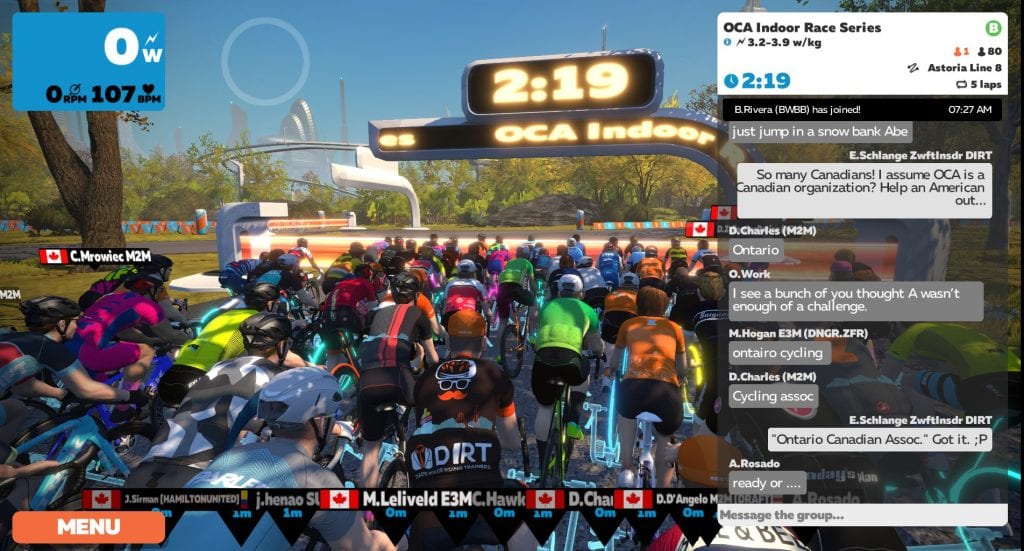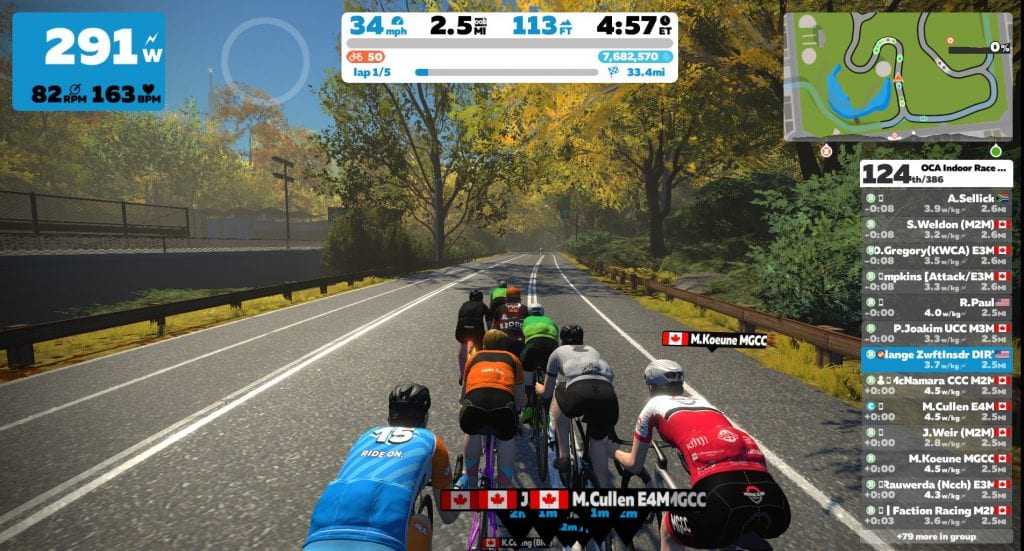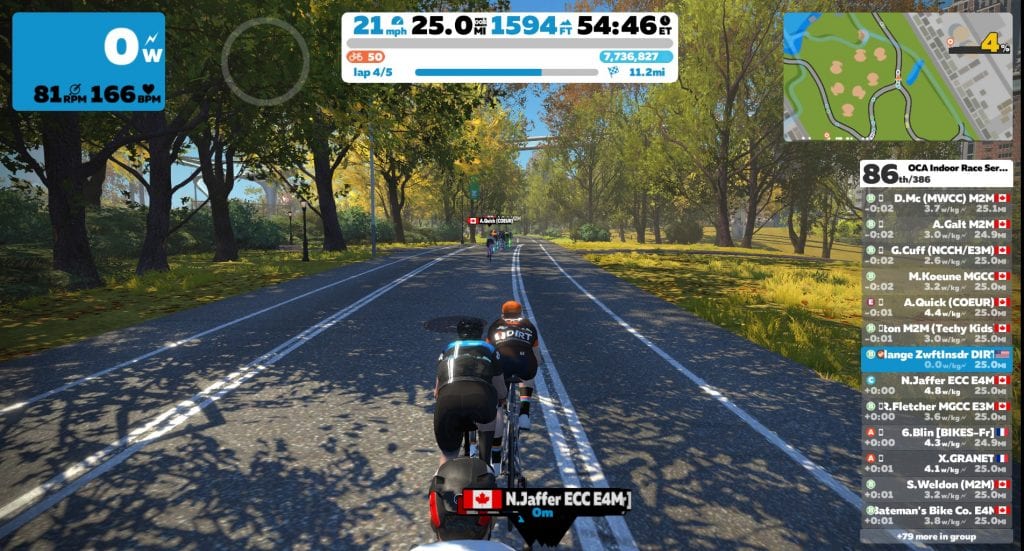Yesterday was my 41st birthday. Fairly fresh legs and a free Saturday morning meant a Zwift race was going to happen. But which race to ride? I scanned the schedule:
- WTRL iTT Series: ugh. A TT on my birthday? That’s no gift.
- Tour for All Stage 2 Race: I’d be racing against the top A racers thanks to how these event categories are structured. Nope!
- DIRT Dadurday Chase Race: not a bad option, but a bit shorter than I’m looking for.
- OCA Indoor Race Series: never heard of it. But it’s 36 miles long, and on a challenging route. Let’s do it!
When I checked the signup list it was stuffed full of Canadians, which made me wonder: what exactly is OCA? It turns out they’re the Ontario Cycling Association and they, like many local cycling associations, are holding a race series on Zwift to help keep their members active during this time. (A note to event organizers: the Zwift world may not know who you are. Help us out and include links and other details about your organization in your event description.)
My B category would be racing 5 laps of NYC’s Astoria Line 8 route – a course I’ve found both fun and challenging in the past. Fun because it’s a rolling course where you go fast but work hard. Challenging because the various short climbs require repeated big efforts for the “overmuscled” cyclist.
The Warm Up
I got on the trainer about 45 minutes early, after my pre-race ritual of three pieces of caffeine gum and PR lotion on the legs. This time I’d be using my new Garmin Vector 3 pedals on my trusty Wahoo KICKR. I spun my way around the Tick Tock route, put in a few digs to get my heart rate up to 160, then it was time to hit the start pens.

The Start
The clock hit zero, and 80+ B’s boiled out of the start pens. But wait, what’s this? A, C, D, and E riders were merging with us from other pens! Noooooo!!
I’ve really got to start paying attention to how these races are set up. That’s two races in a row I’ve joined with combined categories, and I’m just not a fan. Maybe in certain situations I wouldn’t mind jumping in with the A’s and trying to hold on, but I’m not good at switching my race outlook in the middle of a pell-mell start. And I really dislike seeing riders up the road, but not easily knowing if they’re even in my category. In short: I like the simplicity of racing against just my category.
Note: OCA race organizers contacted me after I published this post to let me know that the combined categories were a surprise to everyone, including themselves! Apparently Zwift HQ set up this even incorrectly, and categories will be separated in the future.
This race also had an “E” category, just for the ladies. That was interesting – I’ve never done a mixed race that included a dedicated women’s category. To make it more interesting, each category was racing a different number of laps!
So the A’s were on the front of our strung-out group, pinning it at 31mph, and I just tried to hold on as long as I could. Eventually the elastic snapped, and I found myself in the second group on the road, made up most of B’s and A’s.
New Goals

Racing without a goal is tough for me. And I can’t just have a goal of “doing my best” or “finishing the race.” I need something more tangible.
When you’ve been dropped from the front pack of a Zwift race, what’s your goal? For me, I usually try to work with my chase group to keep the pace high and vacuum up riders who are being dropped from the front group. If I’m feeling feisty I’ll even try to attack through the riders we catch, making it hard for them to grab our wheels.
It’s fulfilling to see my ranking improve as we catch more and more riders, and setting my sights on the riders just up the road gives me something tangible to work toward.
Is this the smartest approach? Perhaps not. It’s a better workout, for sure! But if you’re just going for a top finish, you may be better served by sitting in and conserving energy for the final sprint. It really depends on the race situation – and this was a double draft race, with small packs of riders up the road. That meant our pack could catch these riders if we kept working together. The front of our chase group was 122nd place out of 386 riders. Where could we finish if we kept pushing?
The Middle
Our group worked well together, swelling as the miles piled on. The Astoria Line 8 route has a particular rhythm to it, defined by the longer inclines you encounter. First you have the northern loop, which begins with a climb, then a supertuck-able descent into the twistiest, steepest climb of the route. Despite the climb, I find this section of the route to be pretty fun – supertucking is always a hoot, and the climb afterward is short enough that I can punch it without getting dropped.

The tougher section for me comes just after that northern loop, when you turn left and begin to travel south, encountering a couple of longer rises. Not steep enough to drop me, at least not in today’s race group… but steep and long enough to hurt.
We kept catching riders, and I found myself making calculated decisions on the front of the group. Do I use my powerup to pull us to the next pack? This is a long race, do we just wait to catch them on the next rise? This is one reason I enjoy longer races – the race has more time to evolve, and every move isn’t an emergency.
Disaster Strikes
25 miles into the 36-mile race, I was near the front of our sizable chase group, in 86th place with a group to catch just up the road. And that’s when it happened: my watts suddenly dropped to zero. Nooooo!!!

I hurriedly hit the “A” key to bring up my pairing screen, noting that my cadence (which was from the same Garmin Vector 3 pedals which were currently reading 0) was displaying properly. Very strange. But I couldn’t fiddle around with it – I needed to get moving! I swapped my power source to my KICKR, got back to the game, and assessed the situation as I pedaled up to speed.
My group was already 30 seconds up the road, and I had two riders come up from behind, with no one around me. I wasn’t going to rejoin my big group. #$%&!

Death before DNF
What is your DNF philosophy? I have friends who race (indoors and out) who will pull the plug as soon as they know they can’t win it. This seems silly to me. I once went to a race with a local buddy. We drove two hours to get there, and halfway through the race he got dropped from our front group, turned around, and rode back to his truck. This seems especially silly to me.
I was out of this race. But I was going to finish it! Because I don’t DNF. And certainly not on my birthday.
The Finish
The remaining miles of the race were mostly unremarkable – our small group lacked the legs or gumption to attempt any sort of bridge to the large group which was now minutes ahead. In double draft mode, large groups move so much faster than packs of 2 or 3 – it just isn’t doable without a superhuman effort. So we road together, staying away from those behind, but not working particularly hard, either. You can see in my power chart how my average wattage and speed dropped after my dropout.

Apparently we were lulled into a sense of complacency, because with 2 miles to go we hit one of the cross streets, merging with traffic coming from another section of the course. Suddenly, from behind a pack of riders flew through us! I glanced at the rider list and noticed some of those riders were B’s and A’s, with the same mileage as myself. We’d been caught by a group from behind! Game on.
I sat in with this group, holding onto my feather powerup for the final finish up Cat’s Paw Hill. I stayed within a couple wheels of the front, then gave it all I had to the line, sprinting against two others for a “far from the podium” finish. In the end, one rider from our group beat me over the line. I finished 38th in the B’s, according to Zwift’s results. 22nd according to ZwiftPower.
Without the power drop, I would have finished with the group 3 minutes up the road: somewhere between 10th-20th on ZwiftPower. C’est la vie!
See my activity on Strava >
See my activity on Zwift >
See race results on ZwiftPower >
Takeaways
I had one takeaway from this race: to figure out what the heck happened to my power pedals. And I spent the next hour fixing it.
As it turns out, the pedals had a firmware update available which I hadn’t yet applied. (I won’t go into detail about why I didn’t update the firmware when I first got these pedals a week ago – suffice it to say, Garmin’s app isn’t the best. But let’s save that for another post.)
Firmware version 3.68: “Fixed issue where power would go to 0 over BLE”. Well there you go. Hopefully this issue is resolved for good now!
I’ll be posting a review of the Garmin Vector 3’s, along with a review of the Favero Assiomas, sometime in the future here on Zwift Insider. I will, of course, include the advice to update your firmware!
Questions or Comments
Questions or comments? What’s your view of the dreaded DNF? Share below!